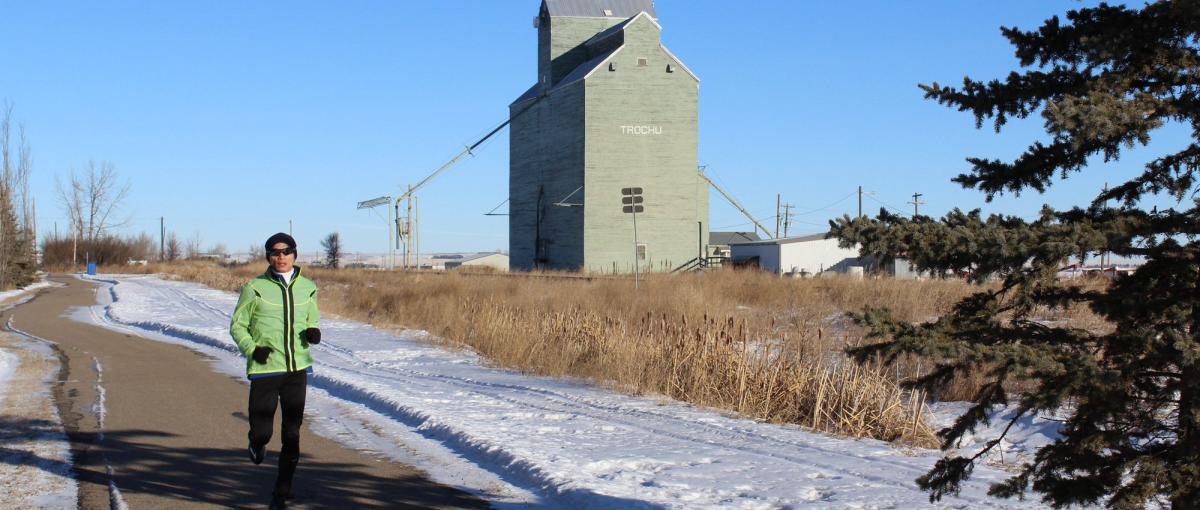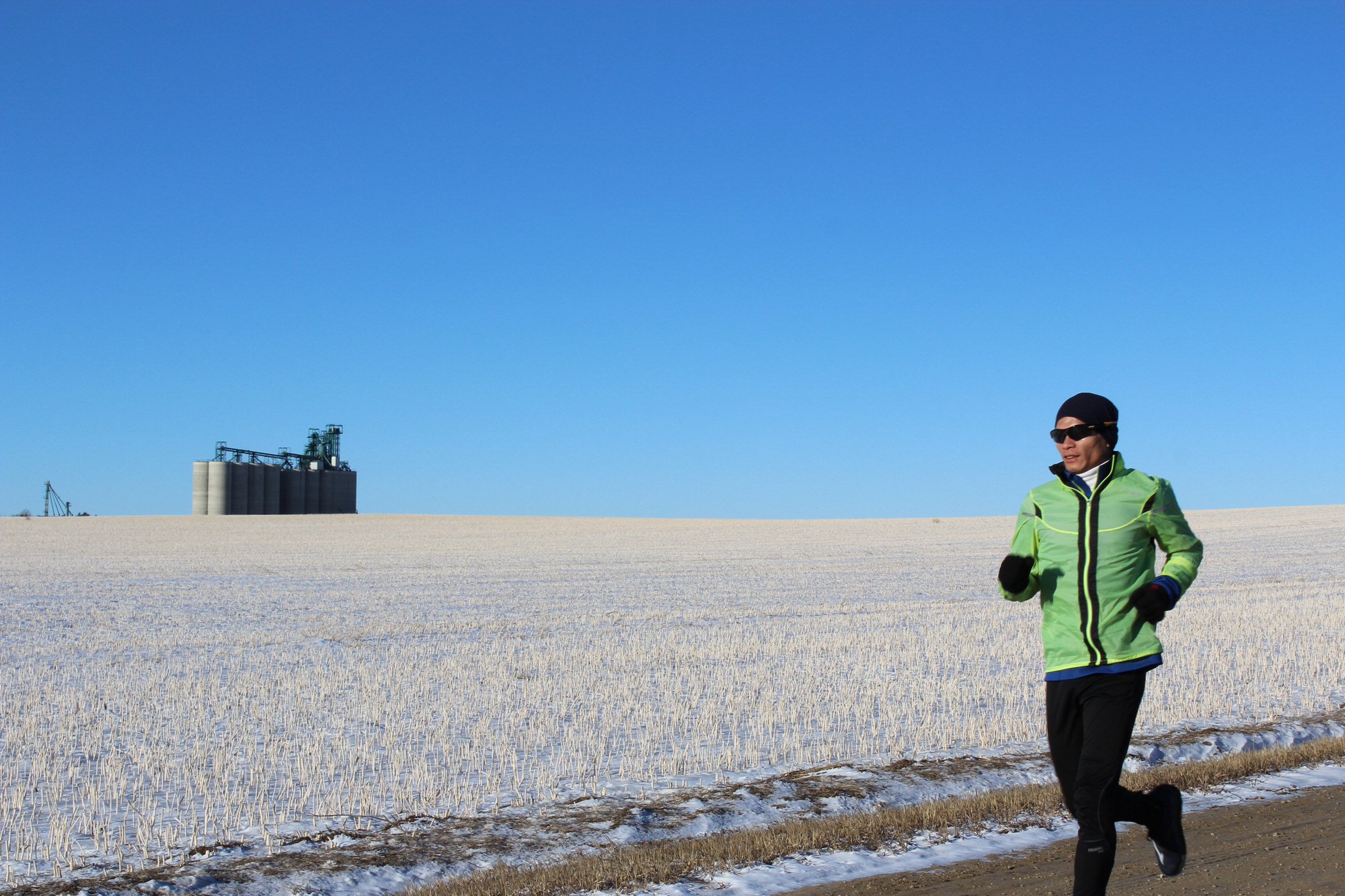Winter workouts: five tips for exercising outdoors

January 2, 2019
By Tessia Verbeek, Senior Advisor, Communications, Covenant Health
New Year’s resolutions are often about getting fit or healthier. But cold weather and gym fees can be a barrier for many people.
Chan Woo is an accomplished marathoner who runs every morning before going into work as Manager of Hospitality Services at Killam Health Centre, Our Lady of the Rosary Hospital in Castor and St. Mary’s Health Care Centre in Trochu.
Chan learned through trial and error how to train outside in the winter.
“I lived most of my life in Malaysia,” he says. “After moving, I wasn’t prepared at all for winter workouts. I froze my hands, I got sick a lot, I didn’t have my flu shot and I didn’t increase my vitamins.”
After some research, Chan began feeling more fit and comfortable with winter workouts. He says it’s possible to exercise outdoors year-round with a few modifications.
He offers some tips for people who want to give winter workouts a try.

Chan Woo says long-term distance runners often put in lots of mileage and training in the wintertime. He believes exercising outdoors in the winter is the best way to prepare himself for exercising and competing in the summertime.
Set your goal
Finding your purpose and setting a goal to achieve it is the first step for every athlete, regardless of your starting level, says Chan.
Chan’s goal is to prepare a strong foundation for the racing season. Training through the winter helps him build mileage, maintain his fitness and emerge race-ready in the spring. That’s why he believes winter is the best time to build healthy habits.
One of Chan’s favourite quotes is from Japan’s Olympic marathon gold medallist, Naoko Takahashi: “In the winter, when the trees are bare, no fruit, no flower, not even leaves are green…. But that’s the time to grow your roots under the ground.”
Whatever your goal may be, training with a future-focused mindset can make exercise more rewarding.
Have a plan before and after a workout
Even as a competitive athlete, Chan can find it difficult to get going every morning. He takes time every night to reflect on his goals so he’s fully present the next day.
“I practise breathing techniques to help clear my head,” says Chan.
Chan recommends a routine to make exercising easy and enjoyable. This includes pre- and post-workout planning.

Chan Woo, a long-distance runner, lays out warm clothes to change into after his morning run. Setting everything up for his post-workout routine eliminates stress and helps him to recover after each workout.
Start by laying out workout clothes and recovery clothes the night before, says Chan.
“I create a flow for myself so I don’t feel rushed,” says Chan. “When I feel rushed, I don’t enjoy the workout.”
Hydration planning is a priority for all fitness levels. Drink lots of fluids before and after working out, says Chan.
Thinking about what you’ll need after your workout is easy to do and often missed, even by experienced athletes, he notes.
“The prime time to recover is 30 minutes after the workout. After 30 minutes, recovery slows down, so preparing everything you need eliminates stress and saves you time.”
In that 30-minute window, Chan takes a warm shower, changes clothes, eats and rehydrates with warm tea.
Dress for the weather
Forget fancy labels or fashion trends; what you wear may have to change with the seasons.
“Waterproof, windproof and breathable clothing is important for winter workouts,” says Chan. “Before I go out the door, I make sure I have a long-sleeved turtleneck, gloves and head protection.”
Chan recommends clothing that protects the throat and upper chest, like turtlenecks or scarves. This shields your lungs from the cold to keep you healthy and active. Other gear to consider includes headwear for various conditions—a stocking cap for cold, a face mask for wind and a cap with a visor to shield from the rain, sun and blinding headlights.
Reflective clothing helps with reduced daylight in the winter.
“I wear a reflective outer jacket and pants,” the marathoner says. “When it’s really dark, I’ll also wear a headlamp.”
Finally, Chan wears running shoes with increased traction to keep his feet dry.
Stay safe and recognize hazards
Chan lives in a rural area. While this gives him country roads and peaceful trails at his disposal, he also has less access to help.
“Cellphone coverage can be limited,” he says. “In an emergency, I might have to rely on farmers passing by instead of calling 911 because I’m so far out.”
Planning ahead and recognizing hazards will decrease your chance of getting into trouble.
One essential tool for Chan is pepper spray. It can protect athletes from threats including animal encounters.
“I bring pepper spray for emergency purposes on every run,” Chan says.
Chan also likes the buddy system: “Some people may want to work out with a friend or a dog. This can increase your safety as well as your motivation to get up and outside.”
Be flexible
Ice, snow and fog can affect your route. Pay attention to the forecast and always be willing to detour, says Chan.
“I run a lot on gravel roads because it provides better traction,” he says.
When it comes to extreme weather, every outdoor athlete has different boundaries.
“I can adjust my gear to match the temperature, but I have to be flexible when the weather is bad,” says Chan. “For example, if it’s too foggy, I won’t run outside, because I’m scared a vehicle will have less visibility and might hit me.”
In that case, indoor workouts may be preferable.
“Sometimes, the best option is to work out in a gym or indoor track because it’s the safest option that day.”